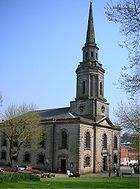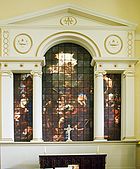
St Paul's Church, Birmingham
Encyclopedia


Georgian architecture
Georgian architecture is the name given in most English-speaking countries to the set of architectural styles current between 1720 and 1840. It is eponymous for the first four British monarchs of the House of Hanover—George I of Great Britain, George II of Great Britain, George III of the United...
St Paul's Square
St Paul's Square, Birmingham
St Paul’s Square, is a Georgian square in the Jewellery Quarter, Birmingham, England, named after the church in its centre. It is the last remaining Georgian Square in the city....
in the Jewellery Quarter
Jewellery Quarter
The Jewellery Quarter is an area of Birmingham City Centre, England, situated in the south of the Hockley area. It is covered by the Ladywood district. There is a population of around 3,000 people in a area....
, Birmingham
Birmingham
Birmingham is a city and metropolitan borough in the West Midlands of England. It is the most populous British city outside the capital London, with a population of 1,036,900 , and lies at the heart of the West Midlands conurbation, the second most populous urban area in the United Kingdom with a...
, England
England
England is a country that is part of the United Kingdom. It shares land borders with Scotland to the north and Wales to the west; the Irish Sea is to the north west, the Celtic Sea to the south west, with the North Sea to the east and the English Channel to the south separating it from continental...
.
The Grade I listed church was designed by Roger Eykyn of Wolverhampton
Wolverhampton
Wolverhampton is a city and metropolitan borough in the West Midlands, England. For Eurostat purposes Walsall and Wolverhampton is a NUTS 3 region and is one of five boroughs or unitary districts that comprise the "West Midlands" NUTS 2 region...
. Building started in 1777, and the church was consecrated in 1779. It was built on land given by Charles Colmore from his Newhall estate. It was the church of Birmingham's early manufacturers and merchants - Matthew Boulton
Matthew Boulton
Matthew Boulton, FRS was an English manufacturer and business partner of Scottish engineer James Watt. In the final quarter of the 18th century the partnership installed hundreds of Boulton & Watt steam engines, which were a great advance on the state of the art, making possible the...
and James Watt
James Watt
James Watt, FRS, FRSE was a Scottish inventor and mechanical engineer whose improvements to the Newcomen steam engine were fundamental to the changes brought by the Industrial Revolution in both his native Great Britain and the rest of the world.While working as an instrument maker at the...
had their own pews, which were bought and sold as commodities at that time.
It is a rectangular church, similar in appearance to St Martin-in-the-Fields
St Martin-in-the-Fields
St Martin-in-the-Fields is an Anglican church at the north-east corner of Trafalgar Square in the City of Westminster, London. Its patron is Saint Martin of Tours.-Roman era:Excavations at the site in 2006 led to the discovery of a grave dated about 410...
, London. The spire was added in 1823 by Francis Goodwin
Francis Goodwin
Francis Goodwin was an English architect, best known for his many provincial churches in the Gothic revival style, civic buildings such as the first Manchester Town Hall and Macclesfield town hall , plus country houses such as Lissadell House, County Sligo .Goodwin was born at King's Lynn,...
.
East window
The east window has an important 1791 enamelled stained glassStained glass
The term stained glass can refer to coloured glass as a material or to works produced from it. Throughout its thousand-year history, the term has been applied almost exclusively to the windows of churches and other significant buildings...
window made in 1791 by Francis Eginton
Francis Eginton
Francis Eginton , was an English glass painter. He painted windows for cathedrals, churches, chapels and stately homes etc. around the country, leaving 50 large works altogether; his work was also exported abroad. His masterpiece is "The conversion of St. Paul", for the east window of St Paul's...
from a painting (c. 1786) by Benjamin West
Benjamin West
Benjamin West, RA was an Anglo-American painter of historical scenes around and after the time of the American War of Independence...
, now in the Dallas Museum of Art
Dallas Museum of Art
The Dallas Museum of Art is a major art museum located in the Arts District of downtown Dallas, Texas, USA, along Woodall Rodgers Freeway between St. Paul and Harwood. In 1984, the museum moved from its previous location in Fair Park to the Arts District, Dallas, Texas...
. It shows the Conversion of Paul
Conversion of Paul
The Conversion of Paul the Apostle, as depicted in the Christian Bible, refers to an event reported to have taken place in the life of Paul of Tarsus which led him to cease persecuting early Christians and to himself become a follower of Jesus; it is normally dated by researchers to AD 33–36...
.
Organ
The church has excellent acoustics and has long given concerts, currently the popular monthly organ recital series 'Thursday Live' by Paul Carr, Organist and Director of Music.The first documented organ in St Paul's was built in 1830 by James Bishop. It was sited on the gallery at the west end of the church. Banfield enlarged the organ in 1838 including a new Swell division which was probably a replacement for Bishop's Swell rather than an addition. Bevington and Sons rebuilt and enlarged the organ in 1871 and again worked on it in 1897.
The organ was moved to its present location in 1927 by Conacher Sheffield & Co. and was extensively rebuilt. However, the organ case could not be accommodated in its new position unaltered. The wings had to be removed and are now joined together to serve as the screen facing the north gallery, along with some recycled pew doors. The side towers could not fit between the mouldings on the north arcade bases, so the entire case-front was raised so that the corbels of the side towers cleared the mouldings. This caused the side-tower cornices to conflict with the arcade capitals, so the cornices were removed.
Following war damage and the resulting weather-related damage, the organ was noted to be in a poor state by 1953, notably the Choir division was completely 'bombed out'. Hill, Norman & Beard remodelled the organ as a two manual and pedal instrument in 1964. This is the organ present today albeit with some additions to the piston system added in 1996. There are a mixture of mechanical and electro-pneumatic actions and soundboards of differing compasses. The pipework consists of some of the original Bishop ranks, some second hand pipework from Hill Norman & Beard's stock in 1964 and one partly new stop – the Great Stopped Diapason.

